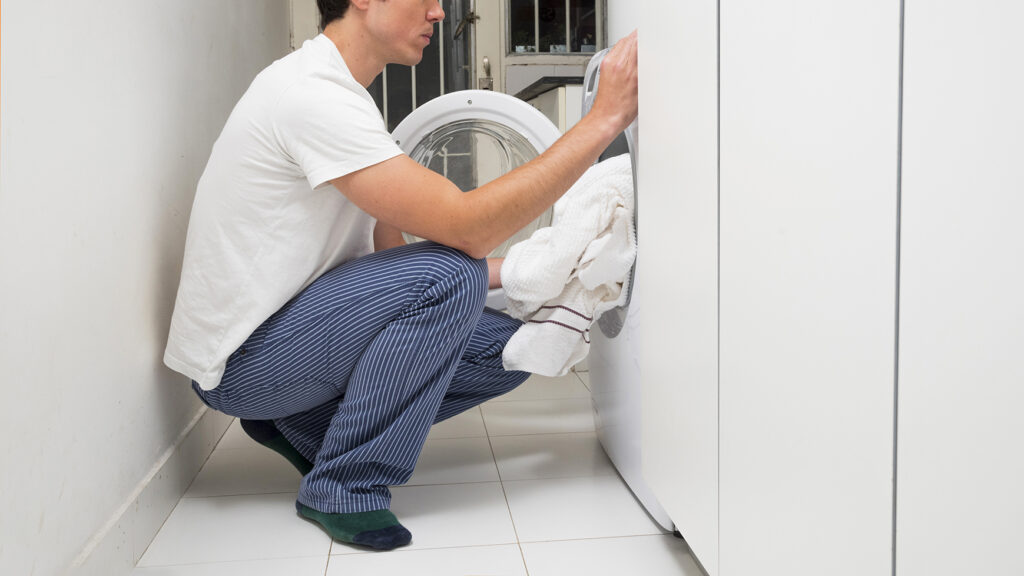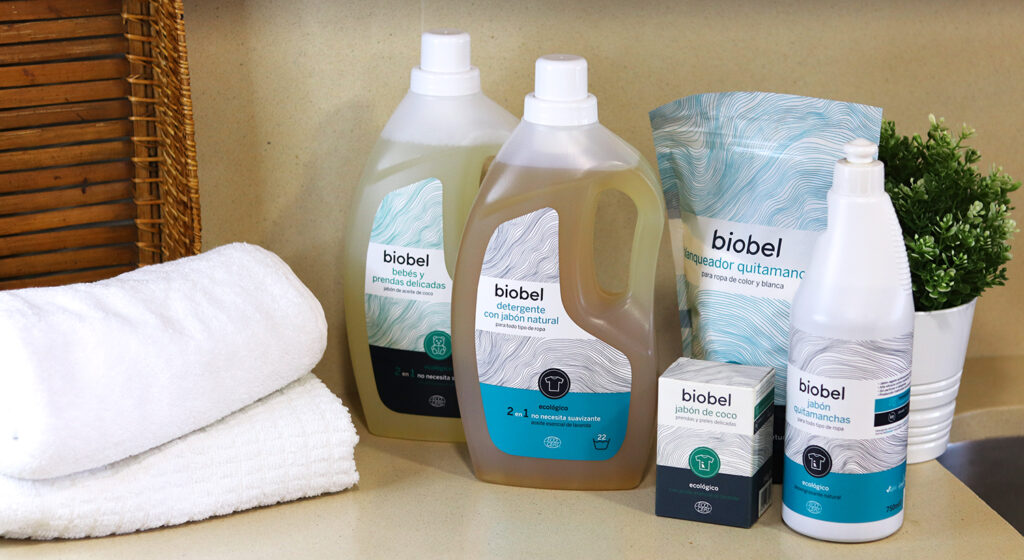When it comes to washing clothes, there are many habits and options open to us which enable us to do the laundry as sustainably as possible. In many cases these are small, simple actions that offer major advantages for our planet, as well as our purse. Washing clothes without contaminating the environment is possible and it is much easier than you might think.
Wash, just what is needed.
As is well known, sustainability begins with the first of the three Rs, reduce. In this case it means minimizing the need to wash so many clothes. This, in turn reduces energy and water consumption, as well as the waste substances that go down the drain, and it also increases how long our garments last: every wash wears fabrics away.
At home we can avoid clothes our getting dirty, stained or losing their smart look by changing into casual home wear, as well as using aprons and also anti-drip devices in wine bottles, for example. Likewise, out of season we can store our clothes neatly folded in boxes or bags, whereby any dust that gathers will not stain or dirty them.
Other recommended habits are to hang your clothes on a coat hanger, or else neatly fold them when getting changed, and so prevent them getting unnecessarily creased. It is also a good idea to air garments that we have not worn for long so they recover their freshness, without us having to wash them.

Key tips for a sustainable wash
Here we offer you a range of advice for a responsible wash. At first sight it might look like a long and complex instruction manual, but in reality it is a series of common-sense measures. If we grasp the reasons behind each tip when we put them all into practice, they will naturally become daily habits.
1. Always wash a full load
The best way to ensure maximum efficiency in terms of water and energy use: the larger a wash load is the consumption of both these resources falls per kilo of clothes. This is the reason why domestic washing machines are now available with a maximum capacity of 9 or even 10 kg, while before they only had a capacity of 7 or 8 kg (measured as dry cotton garments). With regard to top-loading washing machines, the capacity does not usually exceed 7 kg.
However, you should not overload your washing machine. We ought to leave around three fingers of space in the upper part, to ensure that all the clothes wash properly, and to prevent the motor from having to make an excessive effort to spin the drum. The instruction manual for your washing machine usually states the maximum load for each programme.
Another particularly important aspect when loading your washing machine is the preparation of the garments: brush off any mud on trousers (otherwise, it will cause problems for the filters); carefully check pockets in order to avoid pieces of paper, coins or similar objects getting into the machine (they could block the filters or scratch the steel of the drum); unroll sleeves and undo buttons. It is also best to turn trousers, and any other garments that might fade, inside out. And on the subject of fading clothes, don’t forget to wash whites or light-coloured clothes apart from coloured ones! By doing this you’ll stop the bright whiteness fading from of your laundry.
2. Wash at low temperatures
The washing machine is a domestic appliance that consumes more electricity than the fridge, and 90% of its consumption is devoted to warming the water. A 90ºC wash cycle can use up to four times more electricity than a 40ºC one. In reality very few types of dirt need such a high temperature. Usually 30ºC is sufficient, at least for adults’ clothes (it is not advisable to wash at cooler temperatures because cold water reduces the effectiveness of the wash cycle). It is more than sufficient to use 60 ºC for dirtier clothes, as well as reducing allergy risks or the spread of infectious diseases.
Be careful above all with cotton and woollen items, as high temperature wash cycles can result in them shrinking. Silk must always be washed at a cold temperature.
Take care with rapid wash cycles, as they often increase the internal temperature to enhance their effectiveness. If in doubt consult the instructions manual.

3. Buy domestic appliances that have the maximum energy rating
These days one rarely finds washing machines with an energy rating of A+ or lower. The difference in terms of efficiency between the two is around 6%. The most common class is A+++ for some appliances and their energy consumption falls by up to 70% (in fact in March 2021 a new range of classifications updated to the latest technology will be introduced). The most efficient appliances are more expensive, but the higher price is usually recovered before long thanks to the savings made in electricity bills, especially for large households.
With regard to water consumption, this varies greatly depending on the load and programme, whereby a good guide is the average annual consumption that is provided on the energy efficiency rating label. Today, technological advances achieve real marvels in terms of water saving.
It is also a good idea to consider a washing machine’s load capacity; choose the one that is best suited to the number of people in your home and their washing needs. Another interesting criterion is the quality and design of the drum: the less the clothes rubs against it, the less the fabrics will be worn away.
4. Pre-treat heavy stains
If we do not do this, we will have to increase the wash temperature, which means consuming more energy and without any guarantee of success. In fact, some stains become permanent if washed at over 40ºC (protein stains: blood, egg, milk, sweat, chocolate…). As we said at the start, what is most important about stains is preventing them, and secondly removing them as soon as we can.
To do so we can use stain removal products. The Biobel range includes an ecological stain remover made with plant oils.
5. Use bio products
This article set out the most important reasons for opting for ecological cleaning products made with biodegradable plant-based ingredients. Here you can consult the complete range of the Biobel brand.

6. Select the correct dosage depending on how soiled clothes are and water hardness
In order to clean more effectively, at times we are tempted to add more detergent than is indicated by the manufacturer. Major error: an excess of detergent requires the washing machine to extend the rinse phase (which leads to a greater consumption of water). Also, it can result in traces of the detergent being left in clothes, which deteriorates them. If we want to experiment with dosages other than those indicated, it is better to try reducing them for lightly soiled clothes, or if the water is very low in limescale. For example if we have a de-scaler, which is highly recommended for hard water areas, both for the longevity of our appliances and the reduction of maintenance, technical problems and white stains.
In any case, there are now many washing machines that have automatic self-dosage functions. These adjust the dosage with precision in response to the hardness of the water, how concentrated the detergent is, the load weight, how dirty the clothes are and even the type of fabric (white or rigid). All we have to do is to load the detergent drawer for various washes, and the machine uses the minimum required for each wash cycle. This is undoubtedly the most efficient in terms of the consumption of resources.
7. Do not use fabric softeners
If you are using quality ecological detergents, and the dosage recommended for the type of water in your area, your clothes will be left soft, which means fabric softener is unnecessary. By using it, we release chemicals which can affect our health into the washing water, and traces of them can also be left in laundry. One of the most common problems related to fabric softeners are allergies, as these products contain ingredients which we are either allergic to, or they can cause us to develop allergies. On the packaging of a number of fabric softeners, we can read the risk warning: “Can cause an allergic reaction on the skin”. This will be accompanied by a hazard icon, and the list of ingredients often contains polyols, for example, which beside being allergenic also harm the environment.
This is also the case for the ecological brands of fabric softeners that are currently available. A number of these do not display certification seals, and they contain ingredients that are not permitted by the entities that certify ecological products.
Another concern is that around 95% of the weight of the fabric softener is water. Thus, their use involves an unwarranted expense in packaging and transport compared to the minimal benefit they provide if we use quality products.
8. Dry your laundry in the open air.
We live in a country with many hours of sunlight, but also urban planning regulations that hinder you from being able to hang your clothes out to dry, which leads to an increased use of tumble dryers. Using these appliances clothes suffer much more wear than in the washing machine, as there is no water to attenuate the effect of the clothes rubbing against the drum. But aside from this it is a complete aberration in terms of energy, at least in this country.
Undoubtedly the most sustainable option is to hang your laundry out to dry as soon as possible once the washing machine has stopped; this prevents the clothes getting too creased and smelling of damp. Hang them in a well-ventilated place, while avoiding direct contact with the sun. It is above all the air that dries the clothes and the breeze softens them by gently blowing against them. The sun accelerates the drying process, but also dries up and de-colours garments. And although it whitens white garments, too much sun can cause yellowing; therefore, it is recommended to bring your wash in as soon as it is dry.
Hanging out your clothes out to dry also reduces the need for ironing (another major energy source of consumption), above all if we ensure we hang the clothes nice and taut. Use coat hangers to carefully hang garments the right way up so they do not lose their shape, and by doing a button or two up if necessary.

Epilogue: maintenance and renewable energy
Some additional habits to add a few finishing touches to sustainable clothes washing:
- Keep your washing machine’s filters clean. Dirty filters can increase energy consumption by up to 20% during a wash cycle.
- If you live in an area with very hard water, from time to time add a litre of white wine vinegar to the washing machine and set it on a short programme at 60ºC.
- With many washing machines when they complete as wash cycle they do not shut down, but remain on standby, whereby they continue consuming electricity until the next time they are used. It is a good idea to switch your washing machine off manually, and still better to unplug it: even when switched off it consumes electricity, albeit very little.
- If we have to do various washes a day, it is best to do them one after another. That way we can take advantage of the heat inside the washing machine and heating the water for the next cycle will require less energy.
- The evidence for the tragic effects of climate change is emerging at a rapid rate. By buying electricity from a supplier that guarantees a renewable source of electricity, we save the atmosphere from being exposed to more greenhouse gases when we wash our clothes and in our daily life more generally.


Síguenos en: